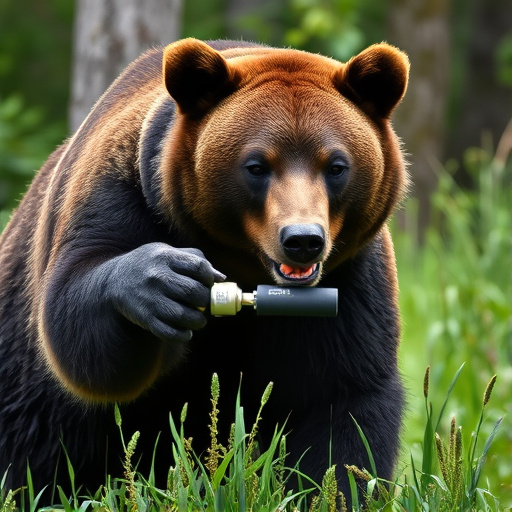Bear spray, an effective deterrent for bear encounters, uses capsaicin to temporarily disorient bears within a 20-35 foot (6-10 meter) range. Its maximum distance coverage is influenced by nozzle design, air pressure, environmental conditions, and atmospheric factors. When selecting bear spray, consider advanced nozzles for long-distance accuracy, can size for protection vs portability, and specific mechanisms for different scenarios. Aim for the bear's face and eyes to maximize disruption, ensuring a safe escape. Proper use includes accessibility, orientation, familiarity with the mechanism, and avoiding accidental pointing at others.
“Uncover the power of bear spray as a vital defense mechanism in unexpected encounters. This compact yet potent tool offers crucial protection against aggressive bears. In this comprehensive guide, we explore the science behind bear spray maximum strength and its surprising effectiveness.
From understanding its active ingredients to deciphering distance coverage, you’ll learn how to choose the right bear spray for optimal safety. Discover expert tips on proper usage, ensuring every spray delivers a safe yet powerful barrier between you and potential threats. Maximize your defense with our insights on bear spray maximum distance coverage.”
- Understanding Bear Spray: What It Is and How It Works
- Factors Determining Maximum Distance Coverage of Bear Spray
- Choosing the Right Bear Spray for Maximum Protection
- Effective Use and Safety Tips for Bear Spray Maximum Distance Coverage
Understanding Bear Spray: What It Is and How It Works
Bear spray, also known as bear repellent, is a powerful defense weapon designed to protect individuals from aggressive bears. It’s more than just a spray; it’s a specialized formula engineered to deter bears when faced with potential threats. The key component in bear spray is capsaicin, the same compound that gives chili peppers their heat. When sprayed, capsaicin irritates a bear’s eyes, nose, and respiratory system, temporarily disorienting and repelling the animal.
The effectiveness of bear spray lies in its maximum distance coverage, allowing users to deploy it from a safe distance. This is crucial when encountering bears in their natural habitat, as it provides an extra layer of protection without provoking the animal. The recommended distance for successful use varies among brands but typically ranges from 20 to 35 feet (6 to 10 meters), ensuring users have time to retreat or deter the bear effectively.
Factors Determining Maximum Distance Coverage of Bear Spray
The maximum distance coverage of bear spray is influenced by several key factors, each playing a crucial role in its effectiveness as a defense weapon. First and foremost, the can’s nozzle design and spray pattern are critical; a wider, more diffused spray will naturally cover a larger area, providing better protection. Additionally, the air pressure within the canister directly impacts range; higher pressure allows for a stronger, farther-reaching spray.
Environmental conditions also significantly affect bear spray maximum distance coverage. Wind direction and speed can either enhance or hinder coverage, with tailwinds extending reach while headwinds reduce it. Terrain features like slopes and vegetation can obstruct or deflect the spray stream, further impacting its effective range. Moreover, temperature and humidity levels can influence the spray’s volatility and dispersion in the air.
Choosing the Right Bear Spray for Maximum Protection
When selecting bear spray, one of the most crucial factors is achieving maximum distance coverage for optimal protection. Look for products that offer a significant range, typically measured in feet, to ensure you can effectively deter an attacking bear from a safe distance. High-quality sprays often come with advanced nozzles designed to project the spray accurately and over longer distances, giving you valuable time to escape or defend yourself.
Consider factors like can size, weight, and the type of aerosol mechanism to find a bear spray that suits your needs. Larger cans provide more spray but may be bulkier, while smaller, lightweight options offer better portability. Additionally, understanding how different mechanisms distribute the spray can help you make an informed choice. Some sprays are designed for wide area coverage, while others focus on direct and powerful streams, each offering unique advantages in various bear encounter scenarios.
Effective Use and Safety Tips for Bear Spray Maximum Distance Coverage
To maximize the effectiveness of bear spray, users should aim for the face and eyes of the bearing animal. This area is highly sensitive, and spraying directly into it can deter the bear from charging further. It’s important to remember that bear spray maximum distance coverage varies between brands and models, but typically ranges from 20 to 35 feet (6 to 10 meters). At this range, a single shot should be enough to disrupt the bear’s behavior and give you valuable time to escape or seek shelter.
Safety tips are crucial when carrying bear spray. Always keep it in an easily accessible location, preferably on your belt or in a holster designed for quick deployment. Ensure the can is oriented correctly with the nozzle facing forward. Before heading into known bear country, familiarize yourself with the spray’s mechanism and practice deploying it so you can react instinctively if needed. Never point it at other people unless in immediate danger, as accidental discharges could harm fellow hikers or wildlife.
Bear spray is an effective defense weapon when facing aggressive bears, with its maximum distance coverage playing a crucial role in ensuring safety. By understanding the factors influencing spray range and choosing the right product, you can increase your protection in bear country. Always follow safety tips for optimal results, as proper usage is key to deterring bears and maintaining a safe distance. Remember, knowledge and preparation are essential tools when navigating potential bear encounters.
